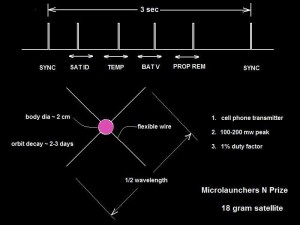Often a breakthrough idea needs to come at just the right time to be successful. Inventor Charles Pooley believes the time for a new field of small, cheap satellite launchers has arrived.
He’s been working on the concept in Mojave, CA for years, and a convergence of events, most notably a couple of prizes for very small satellite launches, may finally allow him to get his ideas and those of a growing list of competitors off the ground.
First came the N-Prize, which I wrote about for Air & Space and Popular Mechanics. Sponsor Paul Dear calls it a “a challenge to launch an impossibly small satellite into orbit on a ludicrously small budget, for a pitifully small cash prize.” Launch a 9.99 to 19.99 gram payload into orbit, and Dear will award you the grand sum of…£9999.99.
Twenty-seven registered teams from around the world are competing to win by the September 19, 2011 deadline, including Pooley’s Microlaunchers.
But there’s a new contest in town, which might just bring on the tipping point for the field. NASA’s new Office of Chief Technologist plans to offer a relatively astronomical $2 million for a so-called cubsat launch that can be duplicated within just one week. The space agency is betting that the time is indeed right for cheap nanosats and a host of new markets that will follow for everything from academic and scientific research to military applications.
NASA’s Nano-Satellite Launch Challenge ups the ante considerably, requiring a one-kilogram payload—up to 100 times greater than that of the N-Prize. But the much greater prize purse might also be enough to spark the independent investment needed to get projects like Pooley’s off the ground. And all it will take is one successful demo flight to open the door to more investment.
Pooley, now living and working Las Vegas, believes that we’re living in a time analogous to the dawn of the micro computer revolution of the 1970s, when computer technology became cheap enough to mass produce, opening the door to the information age. “The technology is now available to fly hundreds of microspacecraft throughout the inner solar system,” says Pooley in a video presentation. He may well be right.
Look for NASA to launch its prize some time in the coming year.



To me, the great part about Microlaunchers was always that Charles was focused on achieving escape velocity and going places.. not just LEO.